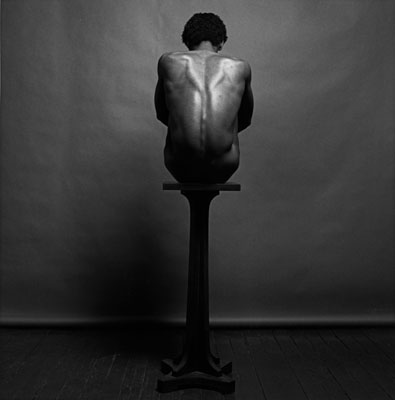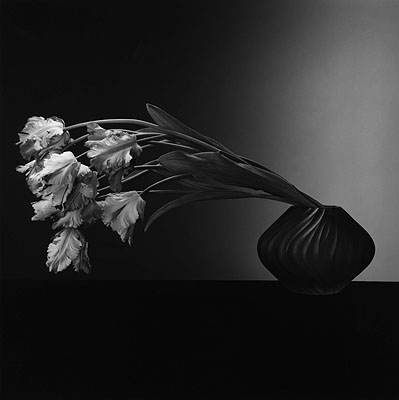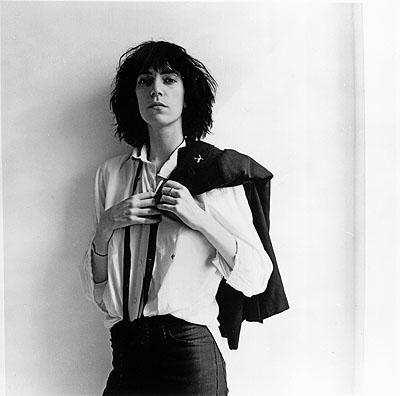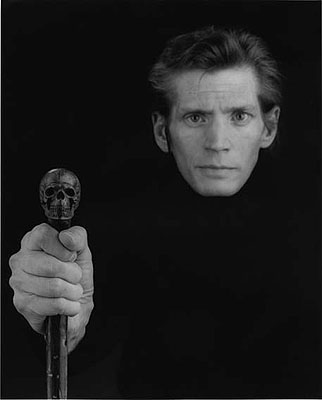
Robert Mapplethorpe »
A Retrospective
Exhibition: 6 Feb – 15 Aug 2010
NRW-Forum Kultur und Wirtschaft
Ehrenhof 2
40479 Düsseldorf

NRW-Forum Düsseldorf
Ehrenhof 2
40479 Düsseldorf
+49 (0)211-8926690
museum@nrw-forum.de
www.nrw-forum.de
Tue-Sun 11-18, Fri 11-22

'Some of the most shocking and indeed some of the most dangerous images in modern photography, or even in the history of art.' Robert Mapplethorpe Robert Mapplethorpe, who was born in 1946 and passed away in 1989, is one of the few artists who truly deserve to be known far beyond the borders of the art world. Mapplethorpe dominated photography in the late twentieth century and paved the way for the recognition of photography as an art form in its own right; he firmly anchored the subject of homosexuality in mass culture and created a classic photographic image, mostly of male bodies, which found its way into commercial photography. In 2010, the NRW-Forum in Düsseldorf will organise a major retrospective of Robert Mapplethorpe's photographs. His work was first shown in Germany in 1977 as part of documenta 6 in Kassel and then in a European solo exhibition in 1981 with German venues in Frankfurt, Hamburg and Munich. In addition to various museum and gallery exhibitions the largest museum exhibition in Germany of Mapplethorpe's work took place in 1997 when the worldwide Mapplethorpe retrospective, which opened at the Louisiana Museum of Modern Art in Denmark, traveled to the Staatsgalerie in Stuttgart. The last time Robert Mapplethorpe's works were shown in Düsseldorf was in the exhibition 'Mapplethorpe versus Rodin' at the Kunsthalle in 1992. Both during his life and since his death, Mapplethorpe's work has been the subject of much controversial debate, particularly in the USA. Right up until the end of the twentieth century, exhibitions of his photographs were sometimes boycotted, censured, or in one case cancelled. His radical portrayals of nudity and sexual acts were always controversial; his photos of sadomasochistic practices in particular caused a stir and frequently resulted in protests outside exhibitions and in one instance, a lawsuits was brought against a museum director. In 2008, the Supreme Court in Japan ruled that Mapplethorpe's erotic images did not contravene the country's ban on pornography and released a volume of his photographs that had been seized and held for over eight years. As far as the American critic Arthur C. Danto was concerned, Mapplethorpe created 'some of the most shocking and indeed some of the most dangerous images in modern photography, or even in the history of art.' In Germany, on the other hand, Mapplethorpe's photographs were part of the 'aesthetic socialisation' of the generations that grew up in the 1980s and early 1990s. Lisa Ortgioes, the presenter of the German women's television programme 'frau tv', notes that during this time, Mapplethorpe's photos were sold as posters; his 'black' portraits in particular being a regular feature on the walls of student bedrooms at the time. The curator of the exhibition, Werner Lippert, is quick to point out that 'this exhibition needs no justification. Mapplethorpe was quite simply and unquestionably one of the most important photographers of the twentieth century. It is an artistic necessity.' The exhibition in the NRW-Forum covers all areas of Mapplethorpe's work, from portraits and self-portraits, homosexuality, nudes, flowers and the quintessence of his oeuvre the photographic images of sculptures, including early Polaroids. The photographs are arranged according to themes such as 'self portraits', which includes the infamous shot of him with a bullwhip inserted in his anus, as well as his almost poetic portraits of his muse, Patti Smith, the photographs of black men versus white women, the body builder Lisa Lyon, the juxtaposition of penises and flowers (which Mapplethorpe himself commented on in an interview: '… I've tried to juxtapose a flower, then a picture of a cock, then a portrait, so that you could see they were the same'), and finally those images of classical beauty based on renaissance sculptures, and impressive portraits of children and celebrities of the day. Despite the obvious references to the Renaissance idea of what constitutes ideal beauty and the history of photography from Wilhelm von Gloeden to Man Ray, this exhibition shows Robert Mapplethorpe as an artist who is firmly anchored is his era; his contemporaries are Andy Warhol and Brice Marden; Polaroids were the medium of choice in the 1970s, and the focus on the body and sexuality was, at the time, for many artists like Vito Acconci or Bruce Nauman a theme that was key to social change. Above all, Robert Mapplethorpe developed his own photographic style that paid homage to the ideals of perfection and form. 'I look for the perfection of form. I do this in portraits, in photographs of penises, in photographs of flowers.' The fact that the photographs are displayed on snow-white walls underpins this view of his work and consciously moves away from the coy Boudoir-style presentation of his photographs on lilac and purple walls a dominant feature of exhibitions of Mapplethorpe's work for many years and opens up the work to a more concept-based, minimalist view of things. The selection of over 150 photographs covers early Polaroids from 1973 to his final self-portraits from the year 1988, which show how marked he was by illness and hint at his impending death, and also includes both many well-known, almost iconic images as well as some never-before seen or rarely shown works. The curators delved deep into the collection of the New York-based Robert Mapplethorpe Foundation to create this retrospective. The exhibition is accompanied by an all-new mobile phone guide. Visitors can use their mobile phones within the NRW-Forum to comment (for the price of a local call) on the various theme rooms and on individual works in the exhibition. These comments and quotes will create a virtual space where the interpretation of Robert Mapplethorpe's work can develop and unfold. The Guide is sponsored by providers BASE and AY YILDIZ (in Turkish language). Note: Many of the motifs in Mapplethorpe's photographs are of an explicitly sexual and homoerotic nature and may be disturbing for or offensive to some visitors, in particular young visitors. Young people under the age of 16 will only be admitted if accompanied by an adult. A programme of educational guides on the exhibition will also be arranged and can be booked at www.nrw-forum.de/fuehrungen.
»einige der schockierendsten - und gefährlichsten - Bilder der modernen Fotografie oder sogar der Kunstgeschichte« Robert Mapplethorpe Eine Retrospektive 6. Februar - 15. August 2010 Der 1946 geborene und 1989 verstorbene Robert Mapplethorpe ist einer der wenigen Künstler, denen es vergönnt ist, weit über die Grenzen der Kunstwelt hinaus bekannt zu werden. Er dominierte die Fotoszene des ausgehenden 20. Jahrhunderts und öffnete den Weg zur Anerkennung der Fotografie als Kunstform, er verankerte das homosexuelle Sujet in der Massenkultur; er entwarf in der Fotografie ein klassizistisches Bild vom meist männlichen Körper, das Eingang in die kommerzielle Fotografie fand. Die Ausstellung im NRW-Forum umfaßt alle Bereiche Mapplethorpes Schaffen wie Portraits und Selbstportraits, Homosexualität, Aktfotografien, Blumenaufnahmen und als Quintessenz die fotografischen Aufnahmen von Skulpturen; sie schließt die frühen Polaroids ein. Die Ausstellung ordnet die Fotografien nach Themen wie - Robert Mapplethorpe und Patti Smith - Cocks and Flowers - Faces and Bodies - Black Men and White Women Diese Zusammenstellung zeigt Robert Mapplethorpe - bei allen offensichtlichen Rückgriffen auf die Schönheitsideale der Renaissance wie auf die fotografische Historie von Wilhelm von Gloeden bis Man Ray - als einen Künstler, der in seiner Zeit verankert war. Die Auswahl von 150 Fotografien umspannt frühe Polaroids von 1973 bis hin zu seinen letzten Selbstportraits aus dem Jahr 1988, die ihn bereits gezeichnet vom nahen Tod zeigen, und präsentiert viele bekannte, geradezu ikonische Motive aber auch bislang nie oder nur selten gezeigte Arbeiten. Sie schöpft aus dem Fundus der New Yorker Robert Mapplethorpe Foundation. Buch zur Ausstellung: Eigens zu dieser Retrospektive legt der Münchener Schirmer-Mosel Verlag Katalog »Robert Mapplethorpe - The Black Book«, der zuerst 1988 erschien, neu auf, zum Preis von 29,80. Sie erhalten es im Internet-Shop von www.nrw-forum.de


© 2010 Robert Mapplethorpe Foundation